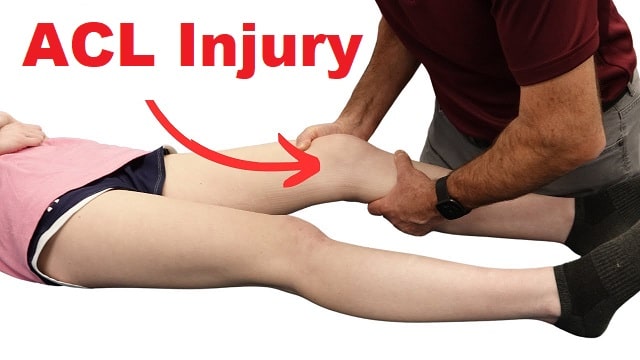What Is an ACL Injury?
Injuries are abnormalities or disorders that occur in body parts, including the feet. One of the most severe foot injuries is an ACL injury.
This injury occurs when there is a tear or damage to the anterior knee ligament. This ligament is the connection between the lower thigh bone and the shin bone to maintain the stability of the knee movement.
This condition is usually experienced by athletes who make sudden movements, hard impacts, or poor landings after jumping.
Symptoms of ACL Injury
After experiencing a blow or injury to the knee area, it is important to know the various symptoms and possibilities of the injury, including ACL injuries.
The signs and symptoms of ACL injury include:
- Severe pain in the knee. Sudden, severe pain is one of the signs of an ACL tear or rupture of the ligament.
- Knees are difficult to move and stretch. ACL injuries can cause limited movement in the knee, making it difficult to move the knee.
- Knee feels unstable. One of the main functions of the ACL is to keep the knee joint stable. If the ACL is torn, the knee may feel unstable or wobbly, especially when trying to walk or change direction.
- Difficulty walking. Pain and discomfort make it difficult for ACL sufferers to walk because of problems with the knee supporting body weight.
- Rapid swelling of the knee. Rapid swelling within approximately 6 hours of injury is a sign that bleeding has occurred within the knee joint.
Knowing these symptoms can be a first step to help in proper diagnosis and treatment.
Therefore, contact a doctor immediately if you experience this condition so that it does not get worse.
Causes of ACL Injuries
ACL injuries often occur as a result of physical activities involving sudden changes in direction, inappropriate jumping, or direct contact to the knee.
In addition, factors such as muscle strength, ligament condition, and sports technique can also influence the risk of ACL injury.
The following are the main causes of injury, namely:
- Making a sudden change of direction (cutting).
- Experiencing a hard impact or kick in the knee area.
- Do a spinning motion with your feet firmly planted.
- Performing a landing movement after jumping.
Risk Factors for ACL Injury
Risk factors are certain conditions or characteristics that make a person more susceptible to ACL injury.
Some risk factors include gender, age, fitness level, type of sport performed, and history of previous injuries.
Factors that increase the risk of injury include:
- Female. Because they have different anatomy and muscle strength with men.
- Participate in certain sports, such as soccer, basketball, volleyball or gymnastics.
- Misaligned foot support when performing activities.
- Performing incorrect movement patterns, such as moving the knees inward when squatting.
- Wearing ill-fitting footwear.
- Playing on synthetic grass.
ACL Injury Diagnosis
First, the doctor will perform a physical examination. Followed by supporting examinations to confirm the diagnosis.
The tests given are:
- X-ray. This test aims to detect fractures in the knee area.
- Magnetic resonance imaging (MRI). This test uses radio waves and a magnetic field to produce images of the hard and soft tissues in your knee on a monitor.
- Ultrasound. The test uses sound waves to visualize the internal structures in the knee area.
ACL Injury Treatment
Initial ACL treatment that can be done by injury sufferers, namely:
- Rest. This method aims to speed up the healing process.
- Ice compress. This can be done every two hours for 20 minutes.
- Compression. This can be done by wrapping the knee with an elastic bandage.
- Position your feet higher. You can do this by positioning your feet higher to increase blood flow in the injured area.
1. Rehabilitation
Patients undergo rehabilitation treatment for several weeks. They will also use a brace to stabilize the knee and use crutches for a while to avoid excessive stress on the joint.
The goal of rehabilitation is to reduce pain and swelling, restore range of motion in the knee, and strengthen muscles. Patients also need to limit their activities.
2. Operation
The doctor will perform this procedure by removing the damaged ligament and replacing it with a tendon segment.
Tendons are tissues similar to ligaments that connect muscles to bones.
Doctors will replace the tendon from a living donor or a deceased person. After surgery, the sufferer will continue a series of rehabilitation therapies.
3. Complications of ACL Injury
Injured people are at high risk of developing osteoarthritis (joint inflammation) in the knee. This disorder can end with surgery to reconstruct the ligaments.
ACL Injury Prevention
Although ACL injuries occur due to various factors, there are several things that can increase the risk of this injury, such as muscle strength and body anatomy.
Therefore, proper warm-up and exercise can help reduce the risk of injury. The best preventive measures are:
- Exercises to strengthen core muscles, including the hips, pelvis, and lower abdomen.
- Exercises to strengthen leg muscles. For example, hamstring exercises to improve the balance of the leg muscles as a whole
- Correct knee positioning when jumping and landing from a jump.
- Training to increase the flexibility of the knee joints when performing rotating movements.

